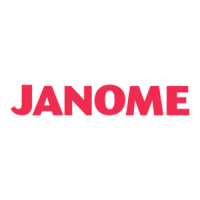133
Chapter 18
Object Details, Fabrics
and Templates
Embroidery object details include general characteristics such as size and
position, as well as embroidery-specific characteristics such as stitch type and
density. The particular settings determine how stitches will be regenerated
when you reshape, transform or scale an object. When you start a new design,
JANOME Embroidery Software uses default settings or ‘values’ stored in the
fabric or template. It provides a set of optimized settings to take into account
the type of fabric you are stitching on.
Embroidery appearance and quality depends a lot on underlay which serves as
a foundation for the cover stitching. Although it increases the stitch count,
underlay helps to stabilize fabrics and reduce puckering and pulling especially
on larger designs. Embroidery stitches pull fabric inward where the needle
penetrates. This can cause gaps to appear in the embroidery. For an object to
sew out correctly, it must have correct stitch spacing, sufficient pull
compensation together with a suitable underlay for the combination of cover
stitch type, object type, object shape and fabric.
Most designs use the ‘Normal’ template, but you can create and use your own.
In fact you can save any combination of settings in a template, such as favorite
stitch or lettering settings. These, however, will generally be overridden by
fabric settings.

